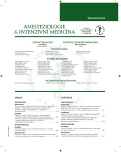OBAAMA-CZ group: Anaesthesia for minor surgery in the postpartum period – Czech prospective national survey
Authors:
Štourač Petr 1,2,6; Bláha Jan 1,3; Nosková Pavlína 1,3; Klozová Radka 1,4; Seidlová Dagmar 1,5; Jarkovský Jiří 6; Zelinková Hana 6; Obaama-Cz Studijní Skupina
Authors‘ workplace:
Expertní skupina pro porodnickou anestezii a analgezii
1; Klinika anesteziologie, resuscitace a intenzivní medicíny, Lékařská fakulta Masarykovy univerzity a Fakultní nemocnice Brno
2; Klinika anesteziologie, resuscitace a intenzivní medicíny, 1. lékařská fakulta Univerzity Karlovy v Prazea Všeobecná fakultní nemocnice v Praze
3; Klinika anesteziologie a resuscitace, 2. lékařská fakulta Univerzity Karlovy v Praze a Fakultní nemocnicev Motole
4; II. anesteziologicko-resuscitační oddělení, Fakultní nemocnice Brno
5; Institut biostatistiky a analýz Masarykovy univerzity
6
Published in:
Anest. intenziv. Med., 25, 2014, č. 5, s. 341-347
Category:
Anaesthesiology - Original Paper
Overview
Aim:
The aim of the national survey was to describe current anaesthesia practice for minor surgery in the earlypostpartum period in the Czech Republic (CZE).
Type of the study:
National prospective observational survey.
Setting:
49 obstetric departments in CZE.
Methods:
We aimed to enrol all the 97 obstetric departments in CZE and to monitor every case of peripartum anaesthetic care during November 2011. Data were recorded to Case Report Form with two parts (Demography 2010 and Case Report) into TrialDB database (Yale University, USA; adapted IBA, MU, CZE). The data were presented descriptively with Statistica 10 software.
Results:
We enrolled 1940 cases of anaesthesiological care from 49 participating centres, and 142 (7.3%) of the cases were during the postpartum period. The most common procedure was manual removal of the placenta (106, 74.6%), instrumental revision of the uterus (56, 39.4%) and repair of postpartum injury (47, 33.1%). General anaesthesia was most commonly used (131, 92.3%), the rest of the cases were in epidural anaesthesia (11, 7.7%). Airway was secured mainly with face mask (88, 67.2%) or orotracheal tube (27, 20.6%). If the patient was intubated, rapid sequence induction (24, 88.9%) with cricoid pressure (15, 55.6%) and suxamethonium (27, 100%) were used in most cases. General anaesthesia was induced with propofol (108, 82.4%) followed by ketamine (33, 25.2%) and thiopentone (12, 9.2%). Intra-operative analgesia was provided by sufentanil (55, 42.0%), alfentanil (28, 21.4%) or fentanyl (16, 12.2%).
Conclusion:
There is a trend to use general anaesthesia with face mask and propofol for minor surgery in the postpartum period in the CZE.
Keywords:
postpartum anaesthesia – airway management – anaesthetic agents
Sources
1. Chestnut, D. et al. Chestnut’s Obstetric Anesthesia: Principles and Practice. Elsevier 2009, ISBN 978-0-323-05541-3.
2. Bláha, J., Nosková, P., Klozová, R., Seidlová, D., Štourač, P., Pařízek, A. Současné postupy v porodnické anestezii II – celková anestezie u císařského řezu. Anesteziologie a intenzivní medicína, 2013, 24, 3, s. 186–192.
3. McDonnell, N. J., Paech, M. J., Clavisi, O. M., Scott, K. L. Difficult and failed intubation in obstetric anaesthesia: an observational study of airway management and complications associated with general anaesthesia for caesarean section. Int. J. Obstet. Anesth., 2009, 17, 4, p. 292–297.
4. Bláha, J., Nosková, P., Klozová, R., Seidlová, D., Štourač, P., Pařízek, A. Současné postupy v porodnické anestezii I – peroperační péče u císařského řezu. Anest. intenziv. Med., 2013, 24, 2, s. 91–101.
5. Boutonnet, M., Faitot, V., Katz, A., Salomon, L., Keita, H. Mallampati class changes during pregnancy, labour, and after delivery: can these be predicted? Br. J. Anaesth., 2010, 104, 1, p. 67–70. doi: 10.1093/bja/aep356.
6. Fenton, P. M., Reynolds, F. Life-saving or ineffective? An observational study of the use of cricoid pressure and maternal outcome in an African setting. Int. J. Obstet. Anesth., 2009, 18, 2, p. 106–110. doi: 10.1016/j.ijoa.2008.07.006.
7. Pařízek, A., Bláha, J., Nosková, P. Porodnická analgezie a ane-stezie v České republice v roce 2012. 20. výročí postgraduálního vzdělávání. Čes. Gynek., 2012, 77, 4, s. 346–349.
8. Štourač, P. Obstetric Anaesthesia and Analgesia Month Attributes – reálná zpráva o anesteziologické praxi na českých porodních odděleních. Anest. intenziv. Med., 2013, 24, 2, s. 81–82.
9. American Society of Anesthesiologists Task Force on Obstetric Anesthesia. Practice guidelines for obstetric anesthesia: an updated report by the American Society of Anesthesiologists Task Force on Obstetric Anesthesia. Anesthesiology, 2007, 106, 4, p. 843–863.
10. Zieleskiewicz, L., Bellefleur, J. P., Antonini, F., Ortega, D., Leone, M., Martin, C. Airway management for anaesthesia performed at the end of labour: survey of practices. Ann. Fr. Anesth. Reanim., 2009, 28, 2, p. 119–123. doi: 10.1016/j.annfar.2008.10.018. [Article in French].
11. Breen, T. W., McNeil, T., Dierenfield, L. Obstetric anesthesia practice in Canada. Can. J. Anaesth., 2000, 47, 12, p. 1230–1242.
12. Ezri, T., Szmuk, P., Stein, A., Konichezky, S., Hagai, T., Geva, D.Peripartum general anasthesia without tracheal intubation: incidence of aspiration pneumonia. Anaesthesia, 2000, 55, 5, p. 421–426.
13. Stept, W. J., Safar, P. Rapid induction/intubation for prevention of gastric content aspiration. Anesth. Analg., 1970, 49, p. 633–636.
14. Kurzová, A. Anestezie a analgezie v porodnictví. In Málek, J.: Praktická anesteziologie. Praha: Grada Publishing, a. s., 2011, s. 158–164.
15. JCAHO alert gives new recommendations for PCA. Hosp. Peer. Rev., 2005, 30, p. 24–25.
16. Herold, I., Černý, V., Cvachovec, K. Doporučení pro poskytování poanestetické péče. Anest. intenziv. Med., 2011, 22, 5, s. 279–282.
17. Rosales-Ortiz, S., Aguado, R. P., Hernandez, R. S., Castore-na, M., Cristobal, F. L., González, M. C., Gallos, I. Carbetocin versus oxytocin for prevention of postpartum haemorrhage: A randomised controlled trial. The Lancet, 383, Suppl. 1, s. 51, doi:10.1016/S0140-6736(14)60314-7.
Labels
Anaesthesiology, Resuscitation and Inten Intensive Care MedicineArticle was published in
Anaesthesiology and Intensive Care Medicine

2014 Issue 5
Most read in this issue
- New direct oral anticoagulants (NOAC) – solutions to potential problems with coagulation assessment
- Theophylline poisoning – case report and review of literature
- Recommendation for analgesia and sedation of adult patients in intensive care
- Triage strategy for urgent management of cardiac tamponade
